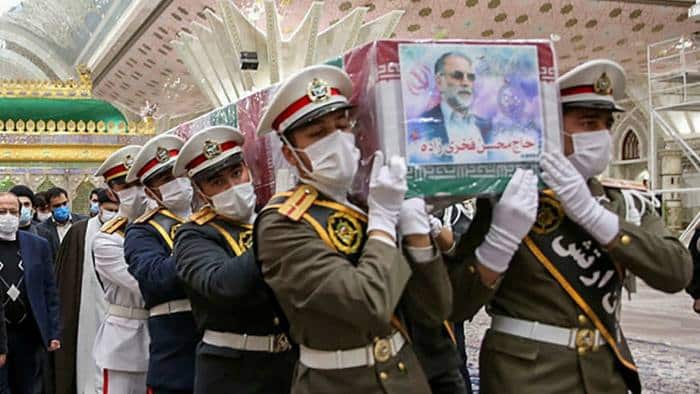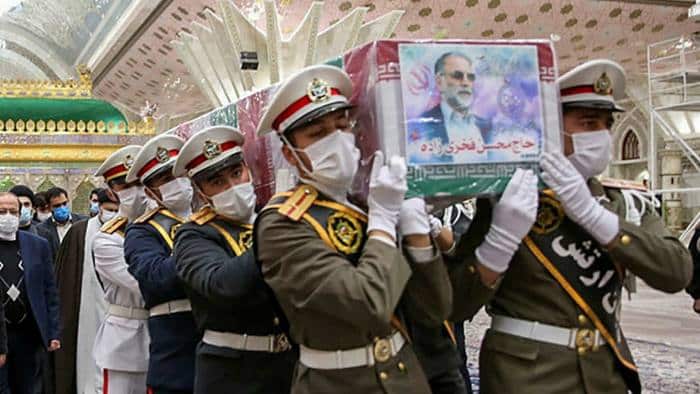
It is not often that one can agree with the pronouncements made by former Central Intelligence Agency (CIA) Director John Brennan, but his tweeted comment on the killing of Iranian scientist Mohsen Fakhrizadeh suggesting that the incident “…was a criminal act & highly reckless. It risks lethal retaliation & a new round of regional conflict. Iranian leaders would be wise to wait for the return of responsible American leadership on the global stage & to resist the urge to respond against perceived culprits” was both restrained and reasonable. Or it was at least so until sentence two, which was clearly intended to attack Donald Trump and praise the incoming Joe Biden administration, which Brennan just might be seeking to join.
Bearing in mind that John Brennan was the guiding hand behind President Barack Obama’s kill lists of Americans who were marked for death by drone it is difficult to understand what moral high ground he seeks to occupy in the slaying of Fakhrizadeh. Brennan, who was a leading critic of Trump and who may have led the clandestine effort to undermine his election and term in office, subsequently found himself in an exchange of tweets with Republican Senator from Texas Ted Cruz which degenerated into a trading of insults. Cruz responded “It’s bizarre to see a former head of the CIA consistently side with Iranian zealots who chant ‘Death to America.’ And reflexively condemn Israel. Does Joe Biden agree?” This produced a riposte by Brennan that “It is typical for you to mischaracterize my comment. Your lawless attitude & simple-minded approach to serious national security matters demonstrate that you are unworthy to represent the good people of Texas.”
The assassination of Fakhrizadeh, the “father of Iran’s nuclear program,” took place on a road near the town of Absard to the east of Tehran. According to initial accounts, the Iranian scientist, who has long been targeted by name and in public fora by Israel, was traveling in an SUV together with his wife plus bodyguards and a driver. Initial reports suggested that there was a Nissan truck parked on the opposite side of the road loaded with what appeared to be wood, though it may have turned out that the wood was concealing a bomb which may have been triggered by a signal from a surveillance satellite. The bomb was detonated to disable Fakhrizadeh’s vehicle before an attack on the car by five or six gunmen with automatic weapons who had emerged from a vehicle following the SUV began, again according to initial reports, including reporting by eye witnesses. The Iranian official news agency FARS is now claiming, however, that the attack was carried out by a remote controlled machine gun concealed on the truck, which subsequently exploded, and no human attackers were involved. It is presumed that the bodyguards and driver were killed in the exchange. Fakhrizadeh was badly wounded and died in hospital shortly thereafter. Photos of the SUV reveal shattered windows, blood streaks, and numerous bullet holes as well as other damage from what may have been the bomb.
Iranian news agencies are now reporting that at least one of the attackers has been arrested, and if that is true he will surely be made to talk regarding what he knows. They are also reporting that two of the assailants were killed in the exchange with the bodyguards, which, if true, means they will possibly be identified. Clearly, the attack was well planned, was able to employ considerable resources, and was based on intelligence that would be very hard to obtain, particularly as the Iranian government was taking steps to protect Fakhrizadeh, to include details of his travels.
The killing comes just two weeks after intelligence officials confirmed that Al Qaeda’s second-highest leader Abdullah Ahmed Abdullah was shot dead together with his daughter by alleged Israeli supplied assassins on a motorcycle on August 7th. The hit was reportedly carried out at the request of the United States based on Abdullah’s claimed involvement in the 1998 deadly attacks on two US Embassies in East Africa. The claim that Iran has been harboring al-Qaeda is already being used by the Trump White House to justify increased pressure on Iran and it might possibly even serve as part of a casus belli.
The two assassinations are not linked except perhaps in terms of sending a message to high level Iranians that they are not safe even in their own country even when they are given bodyguards. The claim that Fakhrizadeh was in charge of a secret Iranian weapons program, made regularly by Israel and the US, is not generally believed by most authorities. Iran is a signatory to the Nuclear Non-Proliferation Treaty, which nuclear armed Israel is not, and its facilities are subject to regular unannounced inspections.
Likewise, the killing of Qods Force commander General Qassem Soleimani in January in a US drone attack was intended more regarding sending a message concerning possible consequences of reckless behavior than it was about actually killing one man. Whatever programs Fakrizadeh and Soleimani were involved in will continue without them. Nevertheless, assassination of Iranians linked to the country’s former and current nuclear program has been Israeli policy since 2010. As many as a dozen Iranian scientists and technicians reportedly have been killed. So-called “targeted killings” have been a regular feature of Israel’s “national defense” strategy. In addition to the Iranians, at least seventy Palestinians have been assassinated.
Though Israel has clearly ordered the assassinations, it is generally believed that the actual preparation for the attacks have been carried out by Mojahedin e Khalq or MEK, a Marxist cult that came into prominence at the time of the Iranian revolution against the Shah. It is generally regarded as a terrorist group that once was virulently anti-American and killed a number of US officials. MEK is a curious hybrid creature in any event in that it pretends to be an alternative government option for Iran even though it is despised by nearly all Iranians. At the same time, it is greatly loved by the Washington Establishment which would like to see the Mullahs deposed and replaced by something more amenable to western and Israeli worldviews.
MEK is run like a cult by its leader Maryam Rajavi, with a number of rules that restrict and control the behavior of its members. One commentarylikens membership in MEK to a modern-day equivalent of slavery. The group currently operates out of a secretive, heavily guarded 84-acre compound in Albania that is covertly supported by the United States, as well as through a “political wing” front office in Paris, where it refers to itself as the National Council of Resistance of Iran.
MEK, which is financially supported by Saudi Arabia, stages events in the United States in Europe where it generously pays politicians like John Bolton, Rudy Giuliani and Elaine Chao to make fifteen-minute speeches praising the organization and everything it does. It’s paying of inside the Beltway power brokers proved so successful that it was removed from the State Department terrorist list in 2012 by Hillary Clinton even though it had killed Americans in the 1970s. MEK also finds favor in Washington because it is used by Israel as a resource for anti-Iranian terrorism acts currently, including assassinations carried out in Tehran. Israel, in fact, directs most terrorist acts carried out by MEK inside Iran.
So those are the players and, at first glance, one might reasonably come to the Ockham’s razor conclusion, i.e. that Israel ordered MEK to kill Fakhrizadeh, an order which was then executed. But that would be to ignore some of the politics currently playing out in Washington. First of all, Israel would not have carried out the high-level assassination without the consent of the White House. Indeed, US intelligence resources might well have played a key role in locating the Iranian scientist. Second, the Trump Administration has clearly adopted a policy of “maximum pressure” against Iran, which has included strangling the country’s economy through sanctions, condoning Israeli attacks in Syria and elsewhere, and destabilizing moves, to include assassinations, designed to make the nation’s leadership both vulnerable and nervous. It is the application of an Israeli strategic doctrine referred to as “Campaigns Between Wars,” meaning constant aggression to erode an enemy’s ability to fight without actually crossing a line that would start a shooting war.
A direct role by the Trump Administration in the assassination should not be ruled out as it is clearly seeking to harden Iranian antipathy towards any new comprehensive arms control or nuclear agreement with the incoming Biden team. Trump himself reportedly raised the possibility of bombing Iran earlier this month, though he was talked out of it by his national security team, but the Israeli Army meanwhile is on alert in case of an American attack. There are confirmed reports that B-52 bombers, capable of deploying the 30,000 pound penetrator bombs that can destroy targets deep underground, have been sent to the Middle East, presumably to Qatar where the US has its principal airbase in the region. They would presumably be used against Iran’s main nuclear development site at Natanz.
Israel is in a strong position right now. Iran has significant military resources to respond to the killing, including the drones and missiles it developed and used in September 2019 to devastate the state-owned Saudi Aramco oil processing facilities at Abqaiq and Khurais in eastern Saudi Arabia. But if it does react robustly to the assassination and sparks a conflict that inevitably would include the United States, it would be a war that Bibi Netanyahu has long sought, destroying Iran at what he hopes would be minimal cost to Israel. If Iran does not respond, Israel will no doubt push the White House to be even more aggressive in its remaining time in office while hardliners within Iran will also demand an end to any agreements with western powers. Taken together, that would make sure that any attempt by the Biden administration to engage diplomatically with Iran would fail. The ultimate provocation by the United States would, of course, be to bomb Iran’s nuclear facilities. Unthinkable? Perhaps, but perhaps not. The Israeli newspaper Haaretz is already reporting that “US President Donald Trump has more than a month before he leaves the White House, and on his way out he could set the world on fire. In starting this conflagration, it seems as though he plans to strike every match in the box. Standing beside him, Prime Minister Benjamin Netanyahu would be more than happy to lend him a lighter.”
Reprinted with permission from Strategic Culture Foundation.

